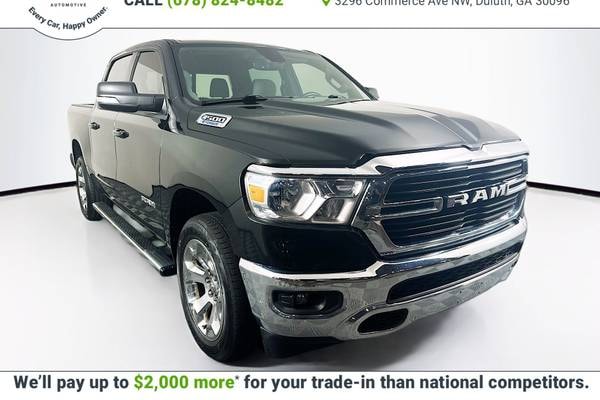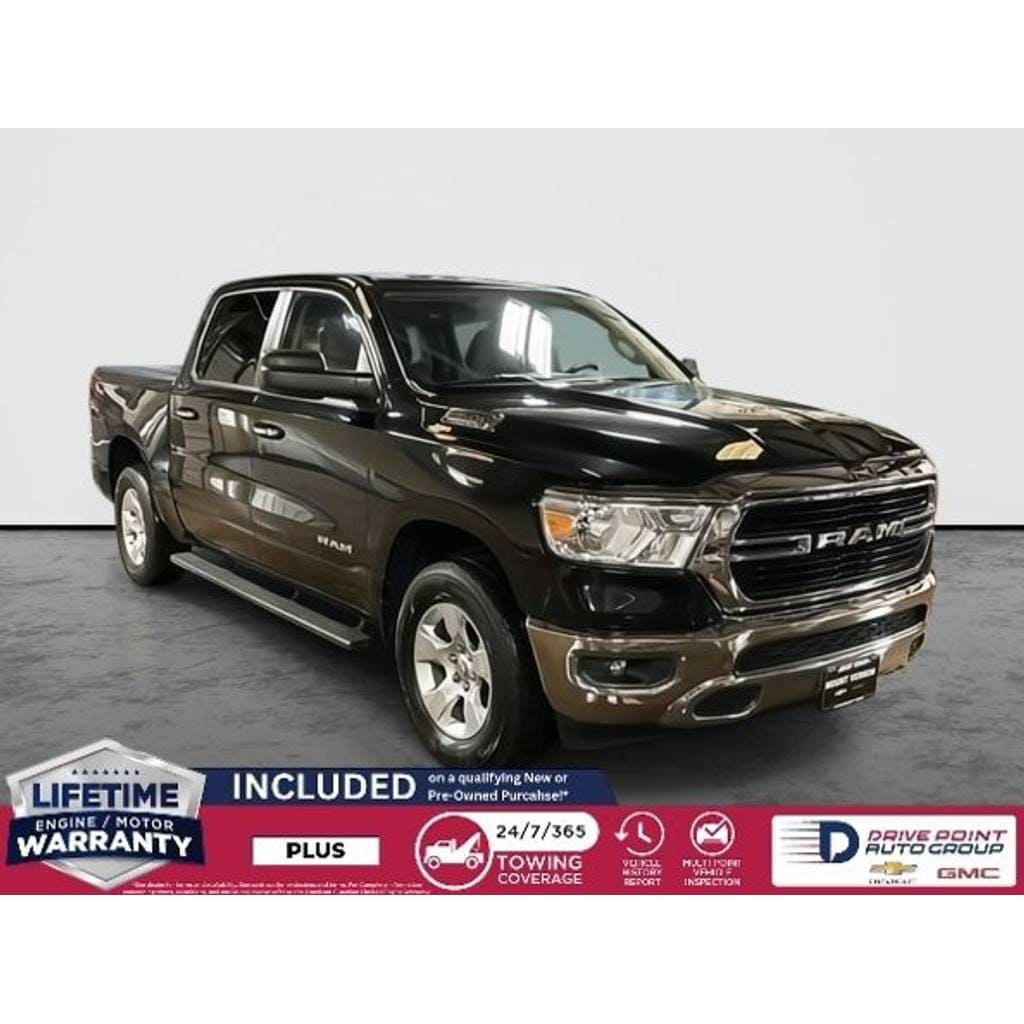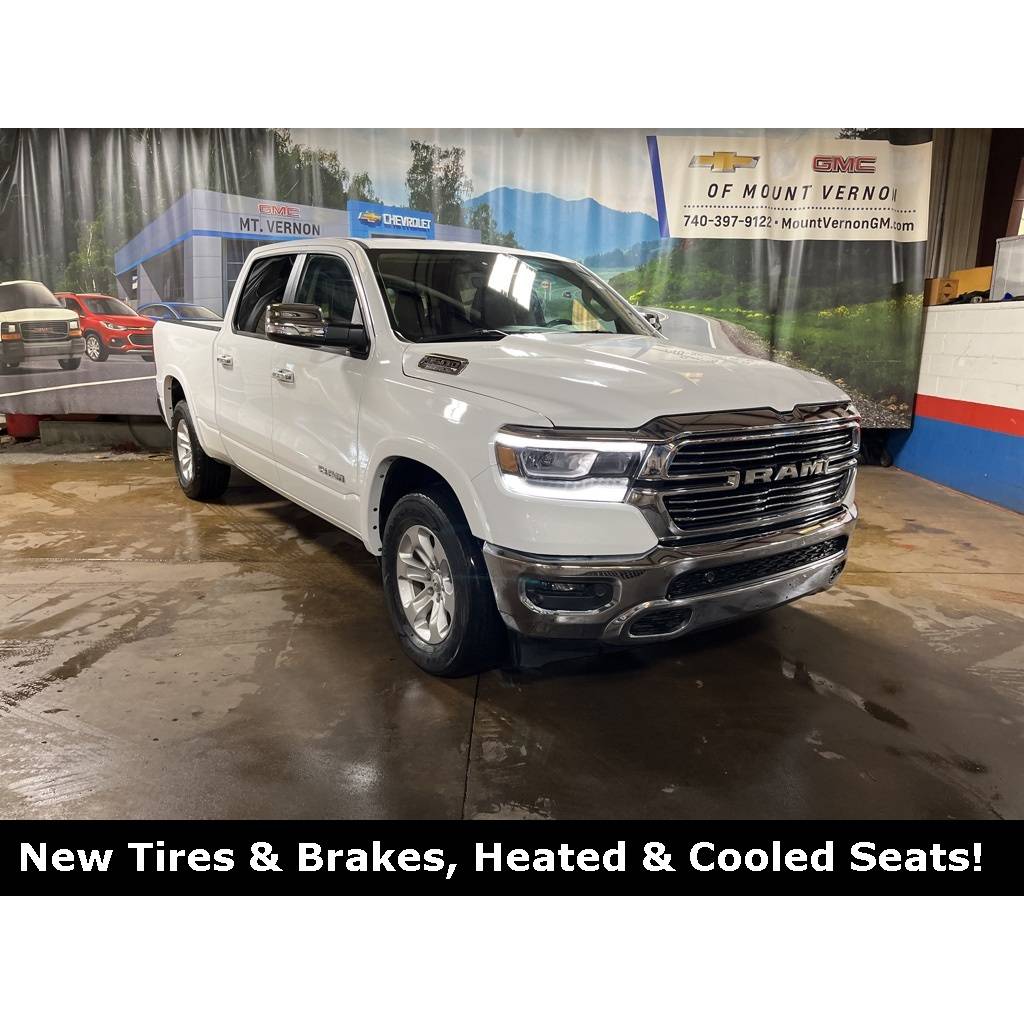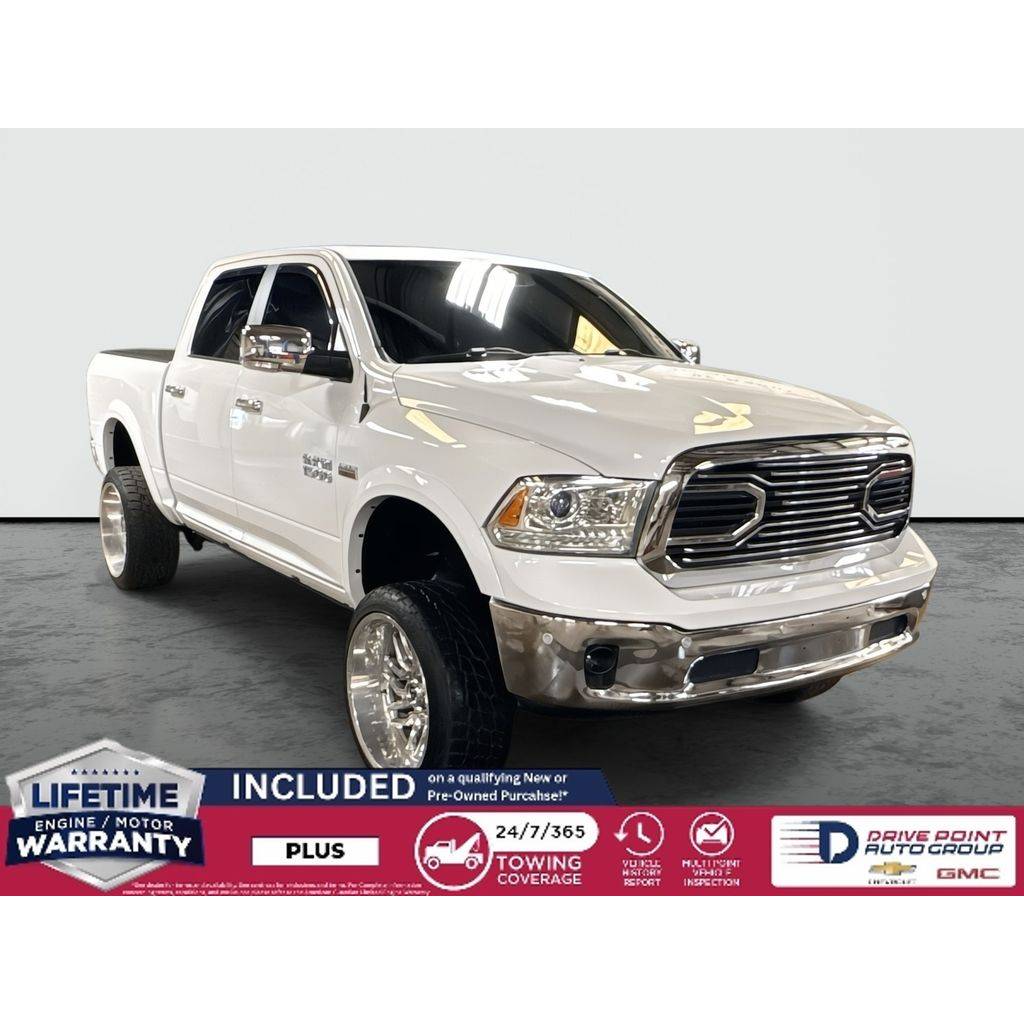- $43,569great price$5,447 below market
- 14,913 miles
- No accidents, 1 owner, personal use only
- 5'7” bed, 5.7l, 8cyl
- Jacky Jones Chrysler Dodge Jeep Ram (56 mi away)
Close
Located in Cleveland, GA / 56 miles away from Stone Mountain, GA
Vehicle DetailsUnleash your adventurous spirit with this stunning 2021 Ram 1500 Laramie, a powerhouse of performance and luxury that’s ready t...
AutoCheck Vehicle History Summary
Accident Free Vehicle: Yes
Personal Use Only: Yes
History Provider: AutoCheck
Title Details: Clean Title
Salvage Vehicle: No
Frame Damage: No
Theft History: No
Lemon Status: No
Free History Report: No
Features and Specs:
Listing Information:
VIN: 1C6RREJT1MN630032
Stock: 1444U
Certified Pre-Owned: Yes
Listed since: 06-24-2025 - $34,950great price$6,760 below market
- 77,431 miles
- No accidents, 2 owners, personal use only
- 5'7” bed, 3l, 6cyl
- Don Jackson North (35 mi away)
Close
Located in Cumming, GA / 35 miles away from Stone Mountain, GA
470-533-5400. MUST MENTION OR PRESENT AD AT TIME OF PURCHASE TO RECEIVE ADVERTISED PRICE. Don Jackson Chrysler Dodge Jeep Ram North offers the most co...
AutoCheck Vehicle History Summary
Accident Free Vehicle: Yes
Personal Use Only: Yes
History Provider: AutoCheck
Title Details: Clean Title
Salvage Vehicle: No
Frame Damage: No
Theft History: No
Lemon Status: No
Free History Report: No
Features and Specs:
Listing Information:
VIN: 1C6SRFHM4MN529654
Stock: R108639A
Certified Pre-Owned: No
Listed since: 06-21-2025 - $38,331great price$6,077 below market
- 34,934 miles
- No accidents, 1 owner, personal use only
- 5'7” bed, 3l, 6cyl
- Gravity Autos Roswell (21 mi away)
Close
Located in Roswell, GA / 21 miles away from Stone Mountain, GA
LOADED REBEL! INCLUDES $13K+ IN OPTIONS! COLD WEATHER GROUP, COMFORT & CONVENIENCE GROUP, CARGO CONVENIENCE GROUP, LEVEL 1 EQUIPMENT GROUP, GRANITE CR...
AutoCheck Vehicle History Summary
Accident Free Vehicle: Yes
Personal Use Only: Yes
History Provider: AutoCheck
Title Details: Clean Title
Salvage Vehicle: No
Frame Damage: No
Theft History: No
Lemon Status: No
Free History Report: No
Features and Specs:
Listing Information:
VIN: 1C6SRFLM8MN686496
Stock: 686496
Certified Pre-Owned: No
Listed since: 04-05-2024 - $21,988great price$2,891 below market
- 168,444 miles
- No accidents, 1 owner, personal use only
- 5'7” bed, 5.7l, 8cyl
- Countryside Chrysler Dodge Jeep Ram of Madison (41 mi away)
Close
Located in Madison, GA / 41 miles away from Stone Mountain, GA
Vehicle DetailsDiscover the power and versatility of the 2021 Ram 1500 Big Horn, now available at our dealership. This rugged yet refined pick...
AutoCheck Vehicle History Summary
Accident Free Vehicle: Yes
Personal Use Only: Yes
History Provider: AutoCheck
Title Details: Clean Title
Salvage Vehicle: No
Frame Damage: No
Theft History: No
Lemon Status: No
Free History Report: No
Features and Specs:
Listing Information:
VIN: 1C6SRFFT0MN509184
Stock: 2R0605A
Certified Pre-Owned: No
Listed since: 05-15-2025 - $32,997good price$3,343 below market
- 27,776 miles
- No accidents, 1 owner, personal use
- 5'7” bed, 3.6l, 6cyl
- EchoPark Automotive Atlanta (Duluth) (11 mi away)
Close
Located in Duluth, GA / 11 miles away from Stone Mountain, GA
At EchoPark, it’s all about offering you options for a happy experience. We have thousands of new-to-you makes and models that range from sedans to tr...
AutoCheck Vehicle History Summary
Accident Free Vehicle: Yes
Personal Use Only: Yes
History Provider: AutoCheck
Title Details: Clean Title
Salvage Vehicle: No
Frame Damage: No
Theft History: No
Lemon Status: No
Free History Report: No
Features and Specs:
21 Combined MPG (19 City/24 Highway)
Listing Information:
VIN: 1C6RRFFG8MN798347
Stock: PMN798347
Certified Pre-Owned: No
Listed since: 06-17-2025 - $67,991good price$7,376 below market
- 60,952 miles
- No accidents, 3 owners, personal use only
- 5'7” bed, 6.2l, 8cyl
- Gravity Autos Roswell (21 mi away)
Close
Located in Roswell, GA / 21 miles away from Stone Mountain, GA
Recent Arrival!Priced below KBB Fair Purchase Price!$18,730 IN UPGRADES,$89,055 MSRP, 4 Way Front Headrests, Adaptive Cruise Control w/Stop & Go, Ad...
AutoCheck Vehicle History Summary
Accident Free Vehicle: Yes
Personal Use Only: Yes
History Provider: AutoCheck
Title Details: Clean Title
Salvage Vehicle: No
Frame Damage: No
Theft History: No
Lemon Status: No
Free History Report: No
Features and Specs:
12 Combined MPG (10 City/14 Highway)
Listing Information:
VIN: 1C6SRFU97MN698911
Stock: 698911
Certified Pre-Owned: No
Listed since: 04-16-2025 - $44,449good price$2,036 below market
- 52,011 miles
- No accidents, 2 owners, personal use only
- 5'7” bed, 5.7l, 8cyl
- Troncalli Chrysler Dodge Jeep Ram (26 mi away)
- Home delivery*
Close
Located in Cumming, GA / 26 miles away from Stone Mountain, GA
2021 Ram 1500 Limited Certified. FCA US LLC Certified Pre-Owned Details: * Limited Warranty: 3 Month/3,000 Mile (whichever comes, ** Bluetooth, ** Bac...
AutoCheck Vehicle History Summary
Accident Free Vehicle: Yes
Personal Use Only: Yes
History Provider: AutoCheck
Title Details: Clean Title
Salvage Vehicle: No
Frame Damage: No
Theft History: No
Lemon Status: No
Free History Report: No
Features and Specs:
Listing Information:
VIN: 1C6SRFHT0MN612103
Stock: J25736A
Certified Pre-Owned: Yes
Listed since: 05-31-2025 - $39,989good price$3,514 below market
- 37,151 miles
- No accidents, 1 owner, personal use only
- 5'7” bed, 5.7l, 8cyl
- Scott Evans Chrysler Dodge Jeep Ram (51 mi away)
Close
Located in Carrollton, GA / 51 miles away from Stone Mountain, GA
Clean CARFAX. CARFAX One-Owner. Odometer is 21249 miles below market average!CARFAX NO ACCIDENTS -----, NAVIGATION SYSTEM, REAR VIEW CAMERA, BLUETOOTH...
AutoCheck Vehicle History Summary
Accident Free Vehicle: Yes
Personal Use Only: Yes
History Provider: AutoCheck
Title Details: Clean Title
Salvage Vehicle: No
Frame Damage: No
Theft History: No
Lemon Status: No
Free History Report: No
Features and Specs:
Listing Information:
VIN: 1C6SRFJT5MN805969
Stock: 25293A
Certified Pre-Owned: No
Listed since: 06-13-2025 - $33,470good price$2,981 below market
- 35,331 miles
- No accidents, 1 owner, personal use only
- 5'7” bed, 5.7l, 8cyl
- ALM Kennesaw (29 mi away)
Close
Located in Kennesaw, GA / 29 miles away from Stone Mountain, GA
BIG HORN LEVEL 1 EQUIPMENT GROUP - A62..QUICK ORDER PACKAGE 25Z BIG HORN - 25Z..WHEELS: 18" X 8" ALUMINUM..RUNNING BOARDS..INTEGRATED TURN SIGNAL MIRR...
AutoCheck Vehicle History Summary
Accident Free Vehicle: Yes
Personal Use Only: Yes
History Provider: AutoCheck
Title Details: Clean Title
Salvage Vehicle: No
Frame Damage: No
Theft History: No
Lemon Status: No
Free History Report: No
Features and Specs:
21 Combined MPG (19 City/24 Highway)
Listing Information:
VIN: 1C6SRFFT0MN766717
Stock: MN766717
Certified Pre-Owned: No
Listed since: 04-25-2025 - $42,820good price$4,910 below market
- 53,030 miles
- 2 accidents, 4 owners, personal use only
- 5'7” bed, 5.7l, 8cyl
- ALM Chrysler Dodge Jeep Ram (96 mi away)
Close
Located in Perry, GA / 96 miles away from Stone Mountain, GA
REBEL LEVEL 2 EQUIPMENT GROUP (A65)..QUICK ORDER PACKAGE 25W REBEL..INSTRUMENT CLUSTER THEME 2 - REBEL..ADVANCE SAFETY GROUP (ALP)..COMFORT/CONVENIENC...
AutoCheck Vehicle History Summary
Accident Free Vehicle: No
Personal Use Only: Yes
History Provider: AutoCheck
Title Details: Clean Title
Salvage Vehicle: No
Frame Damage: No
Theft History: No
Lemon Status: No
Free History Report: No
Features and Specs:
Listing Information:
VIN: 1C6SRFLT7MN624532
Stock: MN624532
Certified Pre-Owned: No
Listed since: 05-12-2025 - $36,995fair price$983 below market
- 80,229 miles
- No accidents, 2 owners, personal use
- 5'7” bed, 5.7l, 8cyl
- Don Jackson North (35 mi away)
Close
Located in Cumming, GA / 35 miles away from Stone Mountain, GA
470-533-5400. MUST MENTION OR PRESENT AD AT TIME OF PURCHASE TO RECEIVE ADVERTISED PRICE. Don Jackson Chrysler Dodge Jeep Ram North offers the most co...
AutoCheck Vehicle History Summary
Accident Free Vehicle: Yes
Personal Use Only: Yes
History Provider: AutoCheck
Title Details: Clean Title
Salvage Vehicle: No
Frame Damage: No
Theft History: No
Lemon Status: No
Free History Report: No
Features and Specs:
Listing Information:
VIN: 1C6SRFJT2MN731412
Stock: R108529A
Certified Pre-Owned: No
Listed since: 05-27-2025 - $72,992fair price$3,109 below market
- 54,769 miles
- No accidents, 4 owners, personal use only
- 5'7” bed, 6.2l, 8cyl
- Gravity Autos Roswell (21 mi away)
Close
Located in Roswell, GA / 21 miles away from Stone Mountain, GA
Recent Arrival!$20K IN UPGRADES!!,$70,325 MSRP, CLEAN CARFAX NO ACCIDENTS, 10 Speakers, 3.55 Rear Axle Ratio, 4 Way Front Headrests, 4-Wheel Disc ...
AutoCheck Vehicle History Summary
Accident Free Vehicle: Yes
Personal Use Only: Yes
History Provider: AutoCheck
Title Details: Clean Title
Salvage Vehicle: No
Frame Damage: No
Theft History: No
Lemon Status: No
Free History Report: No
Features and Specs:
12 Combined MPG (10 City/14 Highway)
Listing Information:
VIN: 1C6SRFU94MN736286
Stock: 736286
Certified Pre-Owned: No
Listed since: 06-16-2025 - $42,375good price$2,824 below market
- 46,245 miles
- No accidents, 1 owner, personal use
- 5'7” bed, 5.7l, 8cyl
- Hayes Chrysler Dodge Jeep Ram of Lawrenceville (13 mi away)
- Home delivery*
Close
Located in Lawrenceville, GA / 13 miles away from Stone Mountain, GA
We are proud to offer this Certified Pre-Owned 2023 Ram 2500 Tradesman in Billet Silver Metallic Clearcoat with a Black interior and 400...
AutoCheck Vehicle History Summary
Accident Free Vehicle: Yes
Personal Use Only: Yes
History Provider: AutoCheck
Title Details: Clean Title
Salvage Vehicle: No
Frame Damage: No
Theft History: No
Lemon Status: No
Free History Report: Yes
Features and Specs:
Listing Information:
VIN: 1C6SRFLT3MN758292
Stock: 21336
Certified Pre-Owned: Yes
Listed since: 06-17-2025 - $41,693good price$2,323 below market
- 60,936 miles
- No accidents, 2 owners, corporate fleet vehicle
- 5'7” bed, 5.7l, 8cyl
- Troncalli Chrysler Dodge Jeep Ram (26 mi away)
- Home delivery*
Close
Located in Cumming, GA / 26 miles away from Stone Mountain, GA
2021 Ram 1500 Limited Certified. FCA US LLC Certified Pre-Owned Details: * Limited Warranty: 3 Month/3,000 Mile (whichever comes, ** Bluetooth, ** Bac...
AutoCheck Vehicle History Summary
Accident Free Vehicle: Yes
Personal Use Only: No
History Provider: AutoCheck
Title Details: Clean Title
Salvage Vehicle: No
Frame Damage: No
Theft History: No
Lemon Status: No
Free History Report: No
Features and Specs:
Listing Information:
VIN: 1C6SRFHT9MN623598
Stock: TQ1028
Certified Pre-Owned: Yes
Listed since: 04-25-2025 - $33,893good price$2,424 below market
- 62,685 miles
- No accidents, 1 owner, personal use
- 5'7” bed, 5.7l, 8cyl
- Hayes Chrysler Dodge Jeep Ram of Gainesville (34 mi away)
Close
Located in Gainesville, GA / 34 miles away from Stone Mountain, GA
We are proud to offer this 2021 Ram 1500 Big Horn in Billet Silver Metallic Clearcoat with a Black interior and 62685 miles. Options Include...
AutoCheck Vehicle History Summary
Accident Free Vehicle: Yes
Personal Use Only: Yes
History Provider: AutoCheck
Title Details: Clean Title
Salvage Vehicle: No
Frame Damage: No
Theft History: No
Lemon Status: No
Free History Report: No
Features and Specs:
Listing Information:
VIN: 1C6SRFFT3MN791224
Stock: 17469
Certified Pre-Owned: No
Listed since: 04-07-2025 - $38,188fair price$720 below market
- 22,975 miles
- No accidents, 1 owner, personal use
- 5'7” bed, 5.7l, 8cyl
- Jim Ellis Chevrolet of Atlanta (12 mi away)
Close
Located in Atlanta, GA / 12 miles away from Stone Mountain, GA
Discover the Power and Luxury of the 2021 Ram 1500 LaramieIn the world of full-size trucks, the 2021 Ram 1500 Laramie stands out as a true masterpiece...
AutoCheck Vehicle History Summary
Accident Free Vehicle: Yes
Personal Use Only: Yes
History Provider: AutoCheck
Title Details: Clean Title
Salvage Vehicle: No
Frame Damage: No
Theft History: No
Lemon Status: No
Free History Report: No
Features and Specs:
Listing Information:
VIN: 1C6RREJT0MN673891
Stock: T15208A
Certified Pre-Owned: No
Listed since: 06-08-2025 - $27,485fair price$965 below market
- 111,408 miles
- No accidents, 2 owners, corporate fleet vehicle
- 5'7” bed, 5.7l, 8cyl
- VC Cars Gwinnett (12 mi away)
Close
Located in Duluth, GA / 12 miles away from Stone Mountain, GA
***PLEASE CALL US FOR A FREE CARFAX REPORT AT 678-869-1900 *** Extended warranty coverage is available for all vehicles upon request. Pricing is dete...
AutoCheck Vehicle History Summary
Accident Free Vehicle: Yes
Personal Use Only: No
History Provider: AutoCheck
Title Details: Clean Title
Salvage Vehicle: No
Frame Damage: No
Theft History: No
Lemon Status: No
Free History Report: No
Features and Specs:
Listing Information:
VIN: 1C6SRFJT8MN665450
Stock: G665450
Certified Pre-Owned: No - $23,988fair price$634 below market
- 151,522 miles
- No accidents, 3 owners, personal use only
- 5'7” bed, 5.7l, 8cyl
- Countryside Chrysler Dodge Jeep Ram of Madison (41 mi away)
Close
Located in Madison, GA / 41 miles away from Stone Mountain, GA
Vehicle DetailsDiscover the power and luxury of the 2021 Ram 1500 Laramie, a standout vehicle that combines rugged capability with refined com...
AutoCheck Vehicle History Summary
Accident Free Vehicle: Yes
Personal Use Only: Yes
History Provider: AutoCheck
Title Details: Clean Title
Salvage Vehicle: No
Frame Damage: No
Theft History: No
Lemon Status: No
Free History Report: No
Features and Specs:
Listing Information:
VIN: 1C6RREJT3MN544107
Stock: 2LP2491
Certified Pre-Owned: No
Listed since: 04-15-2025 - $48,352fair price$959 below market
- 30,007 miles
- No accidents, 1 owner, personal use only
- 5'7” bed, 3l, 6cyl
- AutoNation Chrysler Dodge Jeep Ram North Columbus (98 mi away)
Close
Located in Columbus, GA / 98 miles away from Stone Mountain, GA
Engine: 3.0L V6 Turbo Diesel Gen 3Limited Level 1 Equipment GroupDual-Pane Panoramic SunroofTechnology GroupPanoramic RoofLeather SeatsAnti-Spin...
AutoCheck Vehicle History Summary
Accident Free Vehicle: Yes
Personal Use Only: Yes
History Provider: AutoCheck
Title Details: Clean Title
Salvage Vehicle: No
Frame Damage: No
Theft History: No
Lemon Status: No
Free History Report: No
Features and Specs:
Listing Information:
VIN: 1C6SRFHM4MN791853
Stock: MN791853
Certified Pre-Owned: No
Listed since: 06-09-2025 - $34,998fair price$930 below market
- 46,309 miles
- No accidents, 1 owner, personal use only
- 5'7” bed, 5.7l, 8cyl
- CarMax Athens (39 mi away)
Close
Located in Bogart, GA / 39 miles away from Stone Mountain, GA
CarMax values transparency and wants you to love your next car, not settle on it. Certain vehicles may have unrepaired safety recalls. Check nhtsa.gov...
AutoCheck Vehicle History Summary
Accident Free Vehicle: Yes
Personal Use Only: Yes
History Provider: AutoCheck
Title Details: Clean Title
Salvage Vehicle: No
Frame Damage: No
Theft History: No
Lemon Status: No
Free History Report: No
Features and Specs:
Listing Information:
VIN: 1C6SRFFT8MN745548
Stock: 26828009
Certified Pre-Owned: No - $26,604fair price$477 below market
- 100,533 miles
- No accidents, 1 owner, personal use only
- 5'7” bed, 5.7l, 8cyl
- John Megel Ford (57 mi away)
Close
Located in Cleveland, GA / 57 miles away from Stone Mountain, GA
2nd Row In Floor Storage Bins, Auto-Dimming Exterior Driver Mirror, Auto-Dimming Rear-View Mirror, Big Horn Badge, Big Horn Level 1 Equipment Group, B...
AutoCheck Vehicle History Summary
Accident Free Vehicle: Yes
Personal Use Only: Yes
History Provider: AutoCheck
Title Details: Clean Title
Salvage Vehicle: No
Frame Damage: No
Theft History: No
Lemon Status: No
Free History Report: No
Features and Specs:
Listing Information:
VIN: 1C6RREFT8MN609140
Stock: T63431A
Certified Pre-Owned: No
Listed since: 06-20-2025
Consumer Reviews for the Ram 1500
Issues? Why yes I do
Applied Filters5Active
Make & Model
Year
New / Used
Price & Payments
Price Rating
Trim
Truck Details
Mileage
Accidents & History
Engine & Drivetrain
Exterior Color
Interior Color
Total Seating
Edmunds Review
Features
Options & Packages
MPG
* Delivery of any kind does not apply to Alaska and Hawaii. Contact the dealer for delivery details, restrictions and costs.
























